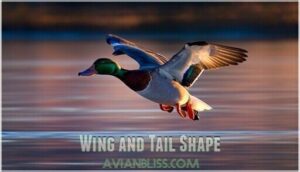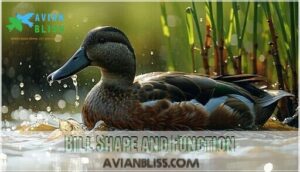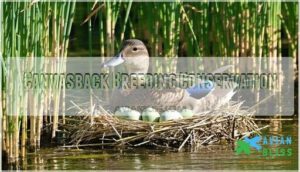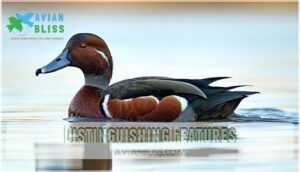This site is supported by our readers. We may earn a commission, at no cost to you, if you purchase through links.

Males showcase striking rusty-red heads with gleaming white bodies, while females display subtle brown tones that still highlight their characteristic profile.
You’ll recognize these impressive birds by their long, dark bills perfectly designed for diving deep into prairie marshes and saltwater bays.
Their powerful build and swift flight make them both challenging quarry for hunters and enchanting subjects for birdwatchers.
These remarkable ducks migrate between northern breeding grounds and coastal wintering areas, where they feed on aquatic vegetation with remarkable diving skills that set them apart from other waterfowl species, showcasing their ability to dive deep into prairie marshes and saltwater bays with ease, and earning them a reputation for being a unique species with distinctive characteristics.
Table Of Contents
- Key Takeaways
- Canvasback Physical Description
- Canvasback Habitat Range
- Canvasback Behavior Diet
- Canvasback Breeding Conservation
- Canvasback Characteristics Identification
- Frequently Asked Questions (FAQs)
- What does a canvasback look like?
- What is canvasback cargo liners?
- What is the difference between a redhead and a canvasback?
- What is canvasback culture?
- Do canvasbacks call?
- Is canvasback a good car protection company?
- Are canvasback ducks good eating?
- What is another name for a canvasback?
- How rare are canvasbacks?
- Why is it called a canvasback?
- Conclusion
Key Takeaways
- You’ll recognize canvasbacks as North America’s largest diving duck – males reach 22 inches with distinctive chestnut heads and white bodies, while females display brown tones with the same characteristic sloping forehead and wedge-shaped bill.
- You’ll find them diving up to 7 feet deep to feed on aquatic vegetation like wild celery and pondweed, using specialized bills perfectly adapted for uprooting plants from lake and marsh bottoms.
- You’ll spot them migrating along four major flyways between northern prairie breeding grounds and coastal wintering areas, with up to 80% of the population gathering in places like Chesapeake Bay and San Francisco Bay.
- You’ll need to support habitat conservation efforts since these ducks depend heavily on prairie potholes for breeding, with over 40% of their wetland habitat lost since 1951, making protection crucial for their stable population of around 566,000 birds.
Canvasback Physical Description
You’ll recognize the canvasback as North America’s largest diving duck, with males reaching up to 22 inches long and weighing nearly 2.5 pounds.
North America’s largest diving duck commands attention with its impressive 22-inch frame and distinctive wedge-shaped profile.
The duck’s distinctive sloping profile and wedge-shaped bill make it stand out among waterfowl, while its size and coloring vary dramatically between males and females, showcasing its unique characteristics.
Size and Color
When you spot a canvasback duck, you’ll notice striking size differences between male and female plumage.
Males display chestnut heads with black chests, while female plumage shows pale brown coloring.
This duck species ranks as North America’s largest diving waterfowl, reaching 22 inches in length.
Size comparison reveals they’re bigger than Ring-necked Ducks but smaller than Common Mergansers, making waterfowl identification easier.
Leg length and color, especially in waders, can also be a key diagnostic tool for identification.
Wing and Tail Shape
Looking at canvasback duck identification, you’ll notice their wingspan averages 31-35 inches, supporting powerful flight stability essential for long migrations.
Their wing aerodynamics enable swift diving and quick takeoffs from water. The short tail provides essential flight control during aerial maneuvers.
Wing markings appear subtle compared to other North American ducks. During molting impact periods, waterfowl identification becomes challenging as flight feathers temporarily change this duck species’ appearance.
Bill Shape and Function
You’ll recognize a canvasback’s unique, wedge-shaped bill that seamlessly connects to its sloping forehead.
This specialized waterfowl anatomy provides exceptional feeding efficiency, allowing the duck to uproot vegetation from lake bottoms with remarkable precision.
The bill’s diving adaptation includes enhanced sensitivity for detecting food underwater, giving canvasbacks an evolutionary advantage over other waterfowl in their aquatic environment.
Canvasback Habitat Range
You’ll find canvasbacks across a vast range that stretches from their northern breeding grounds to southern wintering areas.
These impressive diving ducks follow predictable seasonal patterns, moving between prairie wetlands where they nest and deeper waters where they spend winter months, exhibiting predictable behavior.
Breeding Grounds
You’ll find Canvasback breeding grounds primarily in North America’s Prairie Potholes and Alaskan marshes, where these ducks seek freshwater marshes and prairie marshes with dense nesting vegetation.
These wetland habitats provide essential cover and food sources that directly impact brood survival rates.
Habitat restoration efforts focus on maintaining these vital breeding areas for sustainable Canvasback populations.
Migration Patterns
Canvasback migration follows ancient flyway routes across North America, with birds traveling thousands of miles between breeding and wintering grounds.
These waterfowl respond to Migration Triggers like temperature drops and daylight changes, joining massive V-formation flights that showcase nature’s remarkable navigation skills.
- Migration Triggers – Temperature drops and shortened daylight signal departure time
- Flyway Routes – Four major corridors: Atlantic, Mississippi, Central, and Pacific flyways
- Stopover Sites – Critical refueling locations along traditional bird migration patterns
- Climate Impact – Changing weather patterns alter timing and routes
- Conservation Efforts – Protected corridors guarantee safe waterfowl migration passages
Wintering Locations
When these impressive diving ducks complete their migration, they’ll gather in massive numbers across North America’s premier wintering grounds.
You’ll spot canvasbacks in coastal habitats like Chesapeake Bay and San Francisco Bay, where saltwater bays provide abundant food sources.
These waterfowl also favor freshwater lakes, estuary use areas, and delta regions including the Mississippi River Delta.
The Central Flyway’s waterfowl also use similar habitats.
Up to 80% of the continental population winters in these bay preference locations.
Canvasback Behavior Diet
You’ll discover that canvasbacks are specialized feeders with unique diving abilities that set them apart from other ducks.
Their social patterns and flight characteristics reveal fascinating adaptations for life in North America’s wetlands.
Feeding Habits
When you observe these ducks at their feeding grounds, you’ll notice their remarkable diving abilities.
Canvasbacks plunge up to 7 feet underwater to access aquatic vegetation, especially wild celery tubers and pondweed roots.
These powerful divers rocket to depths of 7 feet, uprooting wild celery with remarkable precision.
Their specialized bill adaptation allows efficient plant excavation from sediment.
Diet composition shifts seasonally – breeding birds consume more mollusks and insect larvae for protein, while wintering populations focus on high-energy plant material through strategic foraging behavior.
Studies show that fennelleaf pondweed constitutes a significant portion of their diet.
Social Behavior
Beyond their feeding routines, these gregarious birds display fascinating flocking dynamics throughout the year.
You’ll notice their cooperative behavior creates natural social hierarchies within mixed flocks:
- Group foraging – Canvasbacks coordinate diving patterns with other ducks
- Mixed flocks – They readily join Redheads and scaups during winter months
- Social hierarchy – Larger males typically dominate prime feeding spots
This bird behavior transforms solitary summer pairs into massive winter rafts of thousands.
Their feeding habits are diverse, and they often use water-based feeding techniques.
Flight Patterns
Watch these powerful diving ducks rocket through the sky at impressive flight speeds of 30-55 mph, with some reaching 72 mph.
During migration, canvasbacks form loose V-formations at high altitudes, their streamlined bodies cutting through air currents.
Their takeoff technique requires a running start across water surfaces before achieving sustained flight.
Canvasbacks are dependent on the health of the Prairie Pothole Region for breeding and their streamlined bodies help them cut through air currents, making them efficient diving ducks.
Canvasback Breeding Conservation
You’ll find canvasback conservation efforts focus on protecting their breeding and wintering habitats, which have declined by roughly 50% since 1950.
Understanding their nesting behavior and population challenges helps explain why these magnificent diving ducks need our continued protection.
Nesting Sites
You’ll find canvasbacks selecting nest sites in shallow wetlands with emergent vegetation that provides cover and protection.
These adaptable ducks show remarkable site fidelity, often returning to successful nesting areas year after year.
To improve nesting success, consider artificial nesting structures.
- Wetland Selection: Choose areas with 1-4 feet of water depth surrounded by cattails or bulrushes
- Nest Construction: Build nests in dense vegetation clusters 10-40 feet from open water
- Site Fidelity: Return to previously successful nesting wetlands in subsequent breeding seasons
- Clutch Size: Prepare nest sites to accommodate 7-9 eggs in well-concealed locations
- Nest Predation: Select sites with overhead cover to reduce visibility from aerial predators
Egg Laying and Incubation
Once you’ve secured the perfect nest site, you’ll observe fascinating breeding behaviors.
Female canvasbacks typically lay 7-9 eggs in their clutch, with incubation lasting 24-28 days.
The female handles all incubation duties while males often abandon the nest site early.
Unfortunately, nest parasitism from other duck species can reduce hatching success rates substantially.
Care of Young
After hatching, canvasback ducklings face immediate challenges in their aquatic environment. Female canvasbacks shoulder primary Parental Roles, guiding their brood to shallow feeding areas rich in aquatic plants and invertebrates.
Duckling Diet consists mainly of protein-rich insects and small crustaceans, essential for rapid Chick Development. This diving duck species teaches young proper feeding behavior through demonstration.
Predator Avoidance strategies include:
- Staying close to dense vegetation cover
- Rapid diving responses to aerial threats
- Cryptic coloration for camouflage
- Silent communication through subtle head movements
- Group vigilance among siblings.
Duck habitat selection proves vital for Fledgling Success, as mothers choose locations with superior duck diet resources while minimizing exposure to predators.
Population Trends
Over 566,000 canvasbacks breed today, matching long-term averages despite dramatic swings between 373,000 and 865,000 since the 1970s.
The North American Breeding Bird Survey tracks these fluctuations, revealing stable populations from 1966-2015.
However, wetland loss impact and habitat degradation create ongoing challenges.
Conservation partnerships like Ducks Unlimited help maintain the IUCN status of "Least Concern" while hunting regulations adjust annually based on population data.
Threats and Challenges
Multiple threats endanger canvasback populations today. Habitat Loss remains the primary concern, with over 40% of prairie wetlands lost since 1951.
Climate Change alters precipitation patterns and water levels, affecting breeding success.
Key challenges include:
- Food Scarcity from declining aquatic vegetation due to Pollution Impact
- Hunting Pressure averaging 75,000 birds annually
- Predation and recruitment difficulties during drought years
These climate threats require ongoing avian conservation efforts.
Canvasback Characteristics Identification
You’ll recognize canvasbacks by their distinctive sloping forehead that seamlessly flows into a long, wedge-shaped bill, creating a smooth profile unlike any other duck.
Their large size, oval body shape, and striking color patterns make them relatively easy to identify once you know what to look for.
Distinguishing Features
When you’re out in the field, the canvasback’s distinctive profile becomes your best friend for bird identification.
Look for that signature sloping forehead that seamlessly blends with the long bill – it’s like nature’s perfect wedge design. Male plumage features a rich chestnut head and neck paired with a black chest, while female plumage displays softer brown tones.
The blue-gray bill color stands out against red eyes in males. Size comparison reveals they’re North America’s largest diving duck, with their unique head shape setting them apart from other waterfowl species.
Accurate identification relies on specific diving duck characteristics, which is crucial for distinguishing them from other waterfowl species with similar traits, and understanding their unique head shape is key to successful identification.
Similar Species
You’ll encounter several diving duck species that share the canvasback’s general appearance, making field identification challenging. The Redhead shows the most similarity, but females display a more rounded head profile compared to the canvasback’s distinctive sloping forehead.
Here are key species comparisons:
- Redhead Comparison – Males have similar reddish heads, but Redheads feature darker backs and more rounded profiles
- Scaup Differences – Both Lesser and Greater Scaups show white-backed males but lack the canvasback’s sloping head shape
- Merganser Contrast – Common Mergansers appear larger with serrated bills designed for fish-catching rather than plant-feeding
- Ring-necked Duck – Smaller overall with distinctive white ring around the bill and different head coloration patterns
- Hybridization Potential – Canvasbacks occasionally crossbreed with Redheads, creating intermediate forms that complicate identification.
Red-breasted mergansers also have a distinct shaggy crest that differentiates them from canvasbacks.
Unique Characteristics
You’ll recognize this bird species by its distinctive wedge bill that’s perfectly adapted for its aquatic diet.
The sloping forehead and stout neck create a streamlined profile that makes this diving duck incredibly efficient underwater.
Aythya valisineria stands out with its unique ability to dive up to seven feet deep, using specialized feeding techniques that set it apart from other waterfowl in bird identification guides.
Frequently Asked Questions (FAQs)
What does a canvasback look like?
You’ll spot a canvasback by its sloping forehead and long bill that seamlessly meets the head.
Males have chestnut heads, black chests, and whitish bodies, while females show pale brown heads with grayish bodies.
What is canvasback cargo liners?
Cargo liners are custom-fitted vehicle interior protection designed to cover your entire cargo area.
They’re made from water-repellent fabrics, not rubber, and come in various colors with secure hook-and-loop fastening systems for maximum coverage.
What is the difference between a redhead and a canvasback?
You’ll notice redheads have rounder heads and yellow eyes, while canvasbacks sport that distinctive sloping forehead with red eyes.
Female canvasbacks also show paler, grayer bodies compared to redheads’ brownish tones.
What is canvasback culture?
You’ll learn about duck social behavior that’s both fascinating and practical.
These diving ducks exhibit gregarious behavior during nonbreeding season, forming large single-species rafts and often mixing with Redheads for winter socializing.
Do canvasbacks call?
Yes, males make soft cooing sounds and females give a guttural krrr-krrr during courtship.
Nonbreeding birds make a wheezing call when other Canvasbacks approach a feeding area.
While you’ll find they’re generally quiet, their vocalizations help with territory and courtship.
Is canvasback a good car protection company?
You’ll find quality car protection through this company’s over 20 years of experience creating custom-fit cargo liners for various vehicle makes and models with excellent customer reviews.
Are canvasback ducks good eating?
Surprisingly, these large diving ducks aren’t considered premium table fare.
You’ll find their meat tends to be tough and fishy-tasting due to their diet of aquatic vegetation and invertebrates from deep waters.
What is another name for a canvasback?
Based on my search, there isn’t a common alternative name for the canvasback duck.
It’s "often called the aristocrat of ducks" due to its distinguished appearance, but "canvasback" remains its primary name.
It’s scientifically known as Aythya valisineria.
How rare are canvasbacks?
Like a roller coaster population, canvasbacks aren’t rare but they’re not abundant either. You’ll find their numbers fluctuating between 400,000-850,000 birds, making them less common than mallards but still huntable.
Why is it called a canvasback?
The name comes from the duck’s distinctive whitish-gray back, which resembles canvas fabric. You’ll notice this canvas-like coloration is most prominent on breeding males, contrasting beautifully with their chestnut heads.
Conclusion
Nearly 80% of canvasback populations depend on prairie pothole regions for successful breeding, highlighting their vulnerability to habitat loss.
The canvasback’s distinctive wedge-shaped profile, impressive diving abilities, and preference for aquatic vegetation make them truly unique among North American waterfowl.
Whether you’re watching them glide across wetlands or observing their powerful flight formations, these aristocratic ducks represent one of nature’s most specialized diving species deserving our continued protection.












